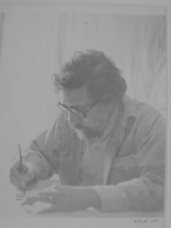Rizkallah's colors - Intriguing, fascinating
9- 10/ 3 / 1983
By Meg Abu Hamadan
Special to the Jordan Times
AMMAN – Watercolors are usually a gentle media, much given to landscapes and still life. In the hands of the Egyptian-born artist Adli Rizkallah, however, they are used to produce rich, colorful provocative abstracts and designs that are intriguing and fascinating.
In the 43 paintings on exhibition at the Al Wasiti Art Gallery until the end of March, Rizkallah conveys two main themes. The first is a simple, literal depiction of village women in his own country. The stylized, repetitive figures from patterns as they glance with their long dresses glowing and swaying in front of palm trees or traditional domed buildings, each of which takes its own place on the pristine, white background as if they had been printed on rather than drawn. Although his works are clearly individually painted, Rizkallah extends the stencil idea by allowing different pools of colour in the women’s dresses to creep tentacle-like one into another, with lines created by marks left by the waters as it dries. The overall effect of women, trees and houses is that they become like hieroglyphic symbols representing the essence of Egyptian countryside culture. Simple, lively and above all joyful, these paintings speak of traditional, basic way of life that has continued unchanged throughout the millennia.
The second theme Rizkallah pursues is much more complex. In abstracts, entitled “Crystals,” he tries to capture in both colour and form, moments of intense personal feeling and total inward awareness. He achieves his aim to some extent – the images have some sensuality and an unsettling voluptuousness. Pale, curved shapes that glow with soft velvet-like sheen of a fallen rose petal are bouyed up by rich, deep colours – magentas, emerald greens and midnight blues – that fold silk like around them. In other works, these vibrant colours gather in small concentrated patches. Looking like microcosms of life floating under a microscope, they add to the intensity of the image, giving an idea of that focusing in on small details that is often absurdly brought about by acute feelings of joy or grief. Although some are more explicit than others, Rizkallah’s paintings on the whole tend to be rather personal than inaccessible. Like his depictions of country women, however, they are very attractive and stimulating works which offer something new. Their ever-changing character makes them easy to live with.
Rizkallah has been involved with many aspects of art and culture all his life. After attending the Academy of Art in Cairo in 1952, Rizkallah participated in many group meetings to discuss art and literature. This led to a period in which the artist experimented with the forms of the Egyptian art in the Coptic era. Realizing that this ultimately did not lead him in the right direction, Rizkallah left Egypt to Paris in 1971. Some ten years later, the artist returned home and ever since he has been trying to establish a personal museum for his own art.
In the 43 paintings on exhibition at the Al Wasiti Art Gallery until the end of March, Rizkallah conveys two main themes. The first is a simple, literal depiction of village women in his own country. The stylized, repetitive figures from patterns as they glance with their long dresses glowing and swaying in front of palm trees or traditional domed buildings, each of which takes its own place on the pristine, white background as if they had been printed on rather than drawn. Although his works are clearly individually painted, Rizkallah extends the stencil idea by allowing different pools of colour in the women’s dresses to creep tentacle-like one into another, with lines created by marks left by the waters as it dries. The overall effect of women, trees and houses is that they become like hieroglyphic symbols representing the essence of Egyptian countryside culture. Simple, lively and above all joyful, these paintings speak of traditional, basic way of life that has continued unchanged throughout the millennia.
The second theme Rizkallah pursues is much more complex. In abstracts, entitled “Crystals,” he tries to capture in both colour and form, moments of intense personal feeling and total inward awareness. He achieves his aim to some extent – the images have some sensuality and an unsettling voluptuousness. Pale, curved shapes that glow with soft velvet-like sheen of a fallen rose petal are bouyed up by rich, deep colours – magentas, emerald greens and midnight blues – that fold silk like around them. In other works, these vibrant colours gather in small concentrated patches. Looking like microcosms of life floating under a microscope, they add to the intensity of the image, giving an idea of that focusing in on small details that is often absurdly brought about by acute feelings of joy or grief. Although some are more explicit than others, Rizkallah’s paintings on the whole tend to be rather personal than inaccessible. Like his depictions of country women, however, they are very attractive and stimulating works which offer something new. Their ever-changing character makes them easy to live with.
Rizkallah has been involved with many aspects of art and culture all his life. After attending the Academy of Art in Cairo in 1952, Rizkallah participated in many group meetings to discuss art and literature. This led to a period in which the artist experimented with the forms of the Egyptian art in the Coptic era. Realizing that this ultimately did not lead him in the right direction, Rizkallah left Egypt to Paris in 1971. Some ten years later, the artist returned home and ever since he has been trying to establish a personal museum for his own art.

